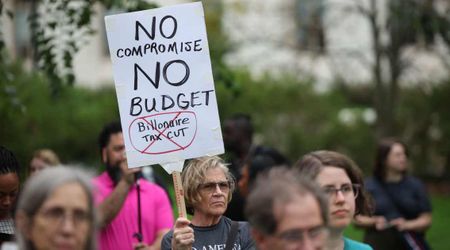This Is How Much UK Government Spent On Queen Elizabeth II's Funeral

The state funeral of Queen Elizabeth II in September last year cost the UK government approximately £162 million ($201.4 million), the treasury revealed Thursday. The Queen was 96.
According to the newly released reports, the cost to the UK government departments included £73.68 million to the Home Office, £57.42 million for the Department for Culture,£2.565 million to the Department for Transport, £2.096 million for the Foreign Office and £2.89 million for the Ministry of Defence.

The Government of Scotland also contributed £18.756 as a low hearse procession and a one-day lying in state was held there. The central UK Treasury said this had been refunded.
The coronation on the other hand is said to have cost between £50 million and £100 million even though nothing has been confirmed.
Key Facts About Queen Elizabeth II's Funeral

The Queen's death was the first state funeral held after the death of Winston Churchill in 1965. A 10-day period of national mourning was observed during which most businesses and workplaces remained open but many events were cancelled ahead of her funeral on September 18 in Westminster Abbey.
An estimated 250,000 paid their last tributes to the British queen lying in state in London during the mourning period. Many even queued in London for over 24 hours including David Beckham who had made headlines at the time.
Queen Elizabeth was buried at St. George's Chapel in Windsor Castle, Berkshire.
The last royal funeral on the other hand was last held in 2002 when Elizabeth's mother, the Queen Mother died. She lay in state for three whole days and her funeral cost was around £5.4 million at the time.
Post the Queen's passing, her eldest son and heir, formerly known as Prince Charles, Prince of Wales, 74, became King Charles III. Charles' wife became Queen Consort and they were both officially crowned on May 6 in a celebratory coronation.
King Charles' Coronation 70 Years After His Mother's

On a typical London day in June 1953, a 27-year-old mother, Elizabeth was coronated as the queen of England. Her coronation was the beginning of a seven-decade reign that saw many changes in the world.
On May 6, 2023, almost 70 years later, a 74-year-old grandfather named Charles, Elizabeth's oldest, was crowned King Charles III.
"This is a coronation like no other," said Christopher Andersen, writer of "The King: The Life of Charles III."The really big, historically unprecedented differences this time around revolve around the two people being crowned and their extraordinary journey to this moment."
While Elizabeth was crowned after the turmoil of World War II, King Charles III was coronated as war rages in many parts of the world and geo-political tensions are on the rise like never before.
Another major change is that the world was less divided when it came to the British monarchy at the time and today King Charles inherits a crown, the need of which is questioned more and more with each passing day.
"There may be some diversity in the parade this time, but these are all PR exercises and not serious attempts to atone for the family's institutionally racist role," says Kehinde Andrews, professor of Black studies at Birmingham City University in England.
"The reality is there is nothing (King Charles) could do but abolish the monarchy if he wanted to reconcile that history and today's present," Andrews said. "The uncomfortable truth is that the royal family is popular because it represents whiteness and is a colonial link to when Britain was 'great.'"
While the coronations look very similar from a distance, the position of the monarchy has since been affected in many ways. The historical backdrops of the coronation differ largely mainly because of the time and age we are in. Will the world only see only a few more coronations? Only time will tell.





















